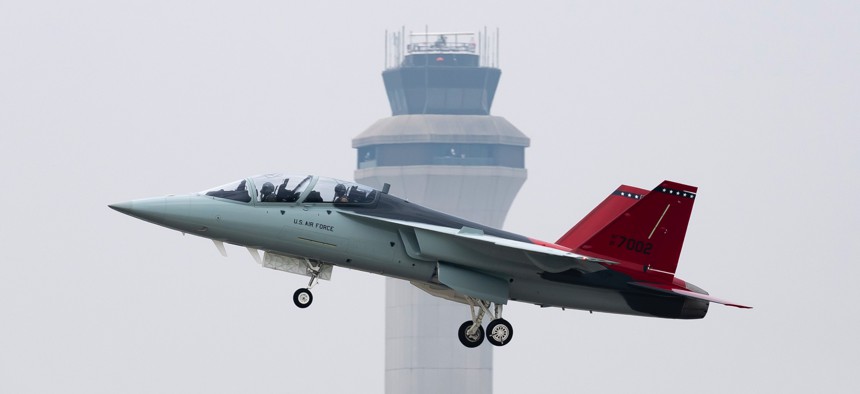
A T-7A Red Hawk, piloted by Maj. Bryce Turner, 416th Flight Test Squadron, takes off from St. Louis Lambert International Airport, Missouri, June 28, 2023. Boeing
Boeing welcomes USAF interest in light-attack version of T-7 trainer
Company’s fighter lead says Air Force officials have discussed the concept multiple times.
DUBAI, UAE—Boeing officials are gushing over the U.S. Air Force’s interest in a combat version of its T-7A training jet, an endeavor that could help the company’s lowball-bid strategy pay off.
Last week, an Air Force official said at the International Fighter Conference in Madrid that a proposed light attack variant of the T-7 might replace aging F-16s—and that wasn’t the first time service officials had talked about it, said Boeing’s Donn Yates.
“Open mission system architecture, low-cost per flight hour, all of that being able to put systems on the aircraft, there are some modifications that we have to make, but it makes sense. So, we absolutely have been looking at that,” said Yates, who leads the company’s Air Force fighter and trainer efforts, at the Dubai Air Show.
The Boeing-Saab T-7A Red Hawk, built to replace the Air Force’s half-century-old T-38 trainers and train new pilots for fifth-generation fighters like the F-35, is years late and has been plagued with problems, notably in the emergency escape system. The Air Force accepted the first five T-7s in September.
“What I will say is this is, as the timeline and some of the problems and challenges that we had kind of put the program kind of in a stagnant point…we're looking at all of these different kinds of options for the future,” Yates said.
To date, Boeing has reported $1.3 billion in losses on the tardy training jet. The company underbid in the original competition; delays and charges have added additional pressures. The T-7 is just one of several programs that Boeing won with a strategy of lowball bids intended to lose money in early production lots but profit on later lots and decades of support contracts.
Yates said the company was “very aggressive” in bidding for the trainer program because “they knew that this was going to happen. So that was part of the strategy early on. It's been a little bit painful because there were some things that happened along the way, but we think we can move past it.”
Boeing and the Air Force have both cited progress on the ejection seat but there is still work to do, Yates said.
“We're going to do additional test shots with some of the learning that [was] had in the escape system shot in February of last year, so there were some recommendations on that as far as changes that we needed to make. We're going to make those changes. We're going to do additional test shots in the new year, and so hopefully there'll be some learning as we continue to evolve that so we still got some work to do on these cases,” Yates said.
Other delays are due to faulty flight control software, which is still being refined, but Yates said they have completed “a lot of the burndown on the risk” of that problem.
Next year, the company will unveil a “new” and “deliberate” plan for the future of the T-7, Yates said.
“When we go out and talk to customers about these concepts, people make conclusions and they come back to say things like they did in Madrid. So F-7 absolutely makes sense,” he said.
The Air Force official who spoke in Madrid said that the service would be issuing a request for information, asking industry to describe what it would take to arm the T-7 for combat, Breaking Defense reported.
Yates said Boeing is in talks with potential T-7 customers in the region and hopes to have some customers from the Middle East soon.
“Every single major country that you can think of who has a training requirement, who is flying F-35 and needs a surrogate or is doing some kind of modernization based on legacy aircraft, every single one of those countries we've talked to talk to. So is there interest? 100 percent,” Yates said.
The trainer has “considerable sales potential” beyond the Air Force, as it’s a contender to replace the U.S. Navy's T-45 jet trainers and other emerging programs to buy a tactical and adversary trainer, said Ray Jaworowski, an analyst with Forecast International.
“Development of a light attack version of the T-7 would further expand the aircraft's market potential. Boeing incorporated considerable growth potential into the design of the T-7, and could adapt the aircraft as needed to meet various requirements,” Jaworowski said.
The Pentagon has launched a few efforts, such as the Air Force’s Advanced Tactical Trainer, or ATT, and the Navy’s Tactical Surrogate Aircraft, or TSA, to develop new training aircraft.
Because the T-7A is unclassified, if the Pentagon wanted a “surrogate” trainer, which could be used as a companion trainer and an adversary, Boeing would need to make alterations if the customer wanted to emulate actual combat systems, Yates said. Boeing is using independent research-and-development funds to start developing a classified trainer, he said.
“We're doing everything we can to match the requirements to the customer to be in a competitive position to win. So there will be some new stuff that we'll talk about quarter one and quarter two of next year,” Yates said.
Boeing has a $9.2 billion contract with the Air Force to deliver 351 T-7s, as well as 46 simulators and ground equipment. The Air Force’s first T-7 landed at Edwards Air Force Base in California for flight testing last week, a production-representative aircraft set up for test and evaluation.
Correction: An earlier version of this report quoted an analyst as saying the T-7 has "considerable sales"; in fact, he said "considerable sales potential."


